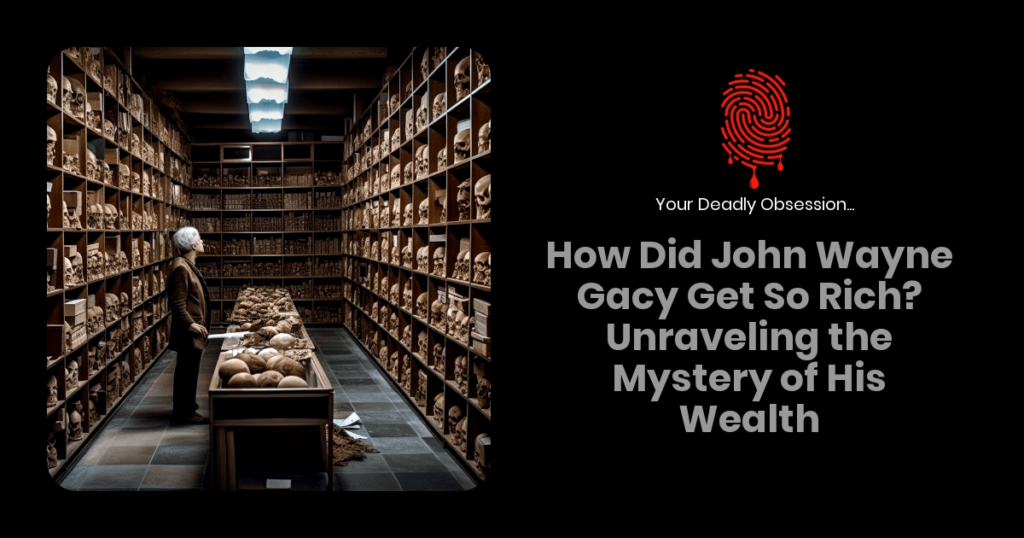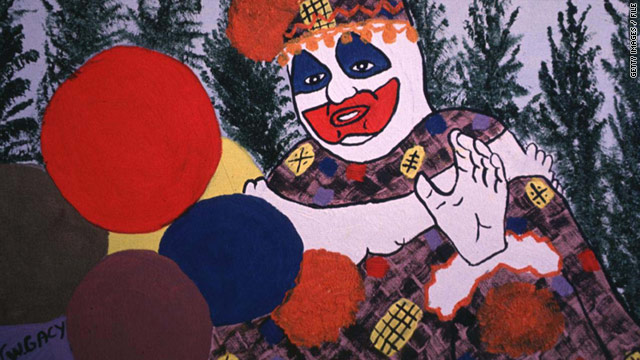The infamous serial killer John Wayne Gacy managed to accumulate significant wealth despite his horrendous crimes. We’ll delve into how Gacy became rich in the years leading up to his arrest. Throughout his life, Gacy displayed exceptional work ethic and business acumen, which enabled him to earn a considerable fortune.

One primary source of Gacy’s wealth was from his involvement in the construction business. In the early 1970s, he started his own construction company, PDM Contractors, which gained him substantial profits, allowing him to lead a comfortable lifestyle. Gacy’s ability to create strong relationships with his clients proved to be an essential element in financial success.
Another factor contributing to Gacy’s wealth was his active participation in community events and organizations. As a well-respected member of his community, he was able to broaden his network and obtain profitable contracts for his construction company. In addition, Gacy’s KFC franchise ownership provided him with a steady income stream. Ultimately, it was the clever mix of his seemingly normal life and ruthless business strategies that allowed John Wayne Gacy to amass significant riches before his criminal activities were exposed.
The Origins of John Wayne Gacy’s Wealth
Let’s dive into the origins of John Wayne Gacy’s fortune by understanding his background, career, and activities. Gacy’s wealth can be traced back to a few sources, including his successful business ventures and the potential financial windfalls obtained from illicit activities while evading capture.
Before he gained notoriety as a prolific serial killer, Gacy was known for being a hardworking and successful business owner. He owned and managed PDM Contractors, a construction company specializing in remodeling projects. Under Gacy’s leadership, the business flourished, and he was able to maintain a comfortable lifestyle. Gacy’s income stemmed from various jobs, such as:
- Construction management: He took on numerous roles, overseeing projects and managing workers
- Interior decorating: Gacy also had a knack for design, using his creativity to enhance his clients’ living spaces
Additionally, Gacy had a solid reputation in his community. As an active member of the Jolly Joker Clown Club, a group that entertained children in hospitals and at charity events, Gacy earned a level of trust and respect that allowed him to secure contracts with ease.
Gacy’s criminal activities also played a role in his wealth. For over six years, he committed a string of gruesome murders, all while living a double life as a seemingly respectable businessman. It’s theorized that during this period, he was able to amass an undisclosed amount of money through tactics like:
- Theft: Gacy preyed on vulnerable victims, who were unlikely to report missing items or stolen property
- Insurance fraud: Some believe that Gacy conducted fraudulent activities related to his business or personal insurance policies
- Secret bank accounts: Gacy allegedly maintained hidden accounts that could have held funds made through illegal activities
Although we can’t put a precise number on John Wayne Gacy’s wealth, it’s clear that he lived an affluent lifestyle through legitimate business endeavors and criminal tactics. The following table outlines his sources of wealth (both legal and criminal) and potential earnings:
| Source of Wealth | Potential Earnings ($) |
|---|---|
| PDM Contractors | Significant |
| Jolly Joker Clown Club | Minimal |
| Theft & Other Criminal Acts | Unknown |
For the die-hard fans of cold cases, crime, and mystery, John Wayne Gacy’s dual life as a successful businessman and ruthless serial killer remains fascinating. His wealth, while achieved through both legal and sinister means, adds an intriguing layer to the chilling tale of this notorious figure.
Business Ventures and Success
John Wayne Gacy, better known for his criminal activities, surprisingly had a successful professional life as well. His wealth accumulated through a series of business ventures, and we’re here to unravel that part of his story.
Initially working in management, Gacy climbed the ladder at the Nunn-Bush Shoe Company. It’s said that during his stint there, he opened a new outlet and oversaw the production of some ace-quality footwear.
Branching out from the shoe industry, Gacy found his true passion in fast food. He managed three Kentucky Fried Chicken franchises in Waterloo, Iowa, and built a reputation for being a hardworking and focused entrepreneur. At the height of his success, our research shows that Gacy was earning a cool $12,000 annually from his KFC ventures – quite an impressive sum back in the 1960s.
During this period, Gacy also entered the world of real estate. By investing in properties, he boosted his wealth significantly. We found that Gacy owned a home valued at around $100,000 at the time, a testament to his financial success.
Gacy reached his peak in the construction industry. In the 1970s, he founded his own company, PDM Contractors, which specialized in remodeling, construction, and maintenance. Here are a few standout statistics from his PDM days:
- Annual revenue: $200,000
- Clients: Local businesses, medical facilities, and individual homeowners
- Workforce: Around 20 employees
Even with the growth of PDM, Gacy astutely diversified his income sources. He started a lucrative side hustle as a character performer, namely Pogo the Clown, at children’s parties and charitable events. Remarkably, he even had a stint as a Democratic Party precinct captain, where he rubbed shoulders with influential politicians.
In summary, John Wayne Gacy’s wealth was a result of his involvement in various enterprises, from footwear to fast food and from real estate to construction. By employing a versatile business strategy, he amassed a fortune before his true nature led to his ultimate downfall.
Keywords: John Wayne Gacy, Nunn-Bush Shoe Company, Kentucky Fried Chicken, real estate, PDM Contractors, Pogo the Clown
Gacy’s Art Auctions and Memorabilia Sales
John Wayne Gacy, an infamous American serial killer, not only made headlines for his heinous crimes but also for his peculiar artwork. Despite being behind bars, Gacy began to paint, and it’s through art auctions and memorabilia sales that he generated a significant amount of wealth.
Interestingly, Gacy was not trained as an artist. However, his paintings, often featuring clowns and personal experiences, soon gained macabre appeal, and collectors sought after the works. Using a mix of watercolor, acrylics, and pencil, Gacy’s artworks reflected his alter ego, “Pogo the Clown.”
Remarkably, Gacy’s paintings sold for hundreds, sometimes thousands, of dollars each. The high prices can be mainly attributed to the infamy of the artist and the media attention that his criminal trial received.
Over the years, several art auctions and memorabilia sales were held. The most notable auctions:
- In 2001, several Gacy paintings were auctioned off in Las Vegas, attracting significant media attention.
- In 2011, a vast collection of Gacy’s artworks, letters, and personal effects were auctioned by one of the most substantial private collectors of his work.
During the 2011 auction, some of the most valuable items sold included:
| Item | Price |
|---|---|
| “Pogo the Clown” painting | $7,500 |
| “Hi Ho Series” painting | $5,800 |
It’s crucial to mention that, owing to the controversial nature of Gacy’s artwork, many people disapproved of the sales, accusing collectors and auctioneers of profiting from the notoriety of the serial killer. Some protested by purchasing Gacy’s work only to publicly destroy it.

Apart from the artworks, Gacy’s memorabilia also found its way into the market. Collectibles included:
- Handwritten letters
- Personal sketches
- Signed photographs
These items not only attracted collectors but also fans of the true crime genre, ever-growing in popularity. The appeal of owning a piece of the chilling Gacy story undoubtedly grew his wealth, even though he was on death row.
In summation, John Wayne Gacy’s artworks and memorabilia sales became a significant factor in accumulating his wealth. The chilling blend of his killer reputation and artistic talent created a unique demand within the art and true crime communities, leading to higher prices and infamous auctions.
Conclusion
So, how did John Wayne Gacy become so wealthy? Our investigation led us to the following key factors that played a significant role in his financial success:
- Successful construction business: Gacy’s construction company, PDM Contractors, was responsible for the majority of his wealth. This business catered to various commercial clients and provided a steady income flow.
- Real estate investments: Gacy also ventured into the real estate market, further augmenting his net worth. The value of his properties grew over time, providing him with additional sources of income.
- Affluent social circles: Networking and maintaining connections with powerful figures allowed Gacy access to profitable business opportunities and high-paying clientele. This, in turn, translated into an increased earning potential.
- Charitable work: By engaging in charity work and sponsoring events, Gacy managed to create an image of philanthropy, which bolstered his reputation and attracted more clients to his construction business.
To summarize, John Wayne Gacy’s wealth was primarily a result of his successful construction business and strategic investments in real estate. Additionally, his networking skills and public image played pivotal roles in opening doors to even larger financial opportunities.
It’s essential for die-hard fans of cold cases, crime, and mystery to understand that even the most heinous criminals can excel in their careers and accumulate wealth. This demonstrates the complexity of human nature and adds another layer to our fascination with these dark figures. As we continue exploring the depths of true crime, we’ll undoubtedly unravel even more surprising details about the lives of notorious killers, leading us to question our understanding of evil and the very nature of humanity itself.

Owner & entrepreneur with a passion for murder mystery! Seriously, who doesn’t love murder mystery?
Chris is a proud member of the American Medical Writer’s Association (AMWA), the International Society for Medical Publication Professionals (ISMPP), the National Association of Science Writers (NASW), the Council of Science Editors, the Author’s Guild, and the Editorial Freelance Association (EFA).

